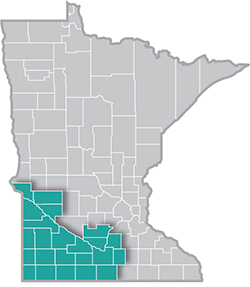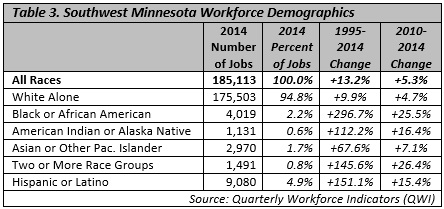 Southwest Minnesota is a national leader in agricultural production, and renewable energy.
Southwest Minnesota is a national leader in agricultural production, and renewable energy.
The region's thriving manufacturing sector includes food processing, machinery, printing, metal products, and computers and electronic products.
Want the freshest data delivered by email? Subscribe to our regional newsletters.
4/15/2016 9:54:04 AM
Luke Greiner
From the rocky shores of Lake Superior in Northeast Minnesota to the wind-swept prairies of Southwest Minnesota, our state has diverse geographic regions. The workforce in Minnesota’s regions are also becoming more diverse over time.
Over the past 20 years, every region in the state saw an increase in the number of jobs held by minorities, with faster increases occurring in southern Minnesota and slower change happening in northern counties (Table 1).
The Twin Cities is still the most diverse region in the state, with nearly one in five jobs held by minorities in 2014. Outside the metro, Southeast Minnesota has the next most diverse workforce, followed by Southwest. The largest minority group of job holders in both southern and central Minnesota were of Hispanic or Latino origin, while American Indians were the largest minority group working in northern Minnesota (Table 2).

Though it had the second smallest number of jobs of the six regions in the state, Southwest Minnesota had the largest number of jobs held by Hispanic or Latino workers in Greater Minnesota, comprising nearly 5 percent of total employment in 2014 (Table 3).

Hispanic or Latino workers in the region were most likely to be found in manufacturing, holding 13 percent of jobs in that industry after nearly doubling since 1995. Health care and social assistance also picked up many new Hispanic or Latino workers over the past 20 years, as did retail trade, accommodation and food services, and agriculture.
The number of jobs held by Black or African American workers increased fastest in Southwest Minnesota from 1995 to 2014, most notably in health care and social assistance, which jumped from 70 jobs in 1995 to 1,318 jobs in 2014. Black workers also gained a foothold in manufacturing, but comprised less than half a percent of jobs in mining, utilities, public administration, and finance and insurance.
Over one-third of the jobs held by Asian or Other Pacific Islanders in Southwest Minnesota were in manufacturing, with another 40 percent spread across health care and social assistance, retail trade, and accommodation and food services.
Despite the increasing diversity of students enrolled in schools in the region, the educational services industry remained non-diverse, with over 97 percent of jobs held by whites. While the region’s schools and colleges saw huge percentage leaps in jobs held by other races over the last two decades, the workforce still doesn’t match the diversity of the students.
Data clearly show that employers are relying more and more on a more diverse labor force across the state. If the next 20 years bring as much change as the last 20 years, every industry in every region will be greatly affected. Different industries have taken different approaches in different regions, but the entire state has seen the same result – a more diverse workforce. To learn about the other regions, read the complete “Diversity gains momentum in Greater Minnesota” article in Employment Review.
Contact Luke Greiner at 320-308-5378 or Mark Schultz.